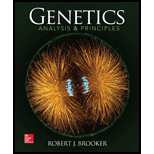
Concept explainers
Describe the similarities and differences between homologous recombination involving sister chromatid exchange (SCE) and that involving homologs. Would you expect the same types of proteins to be involved in both processes? Explain.
To review:
The similarities and differences between the recombination and the sister chromatid exchange in respect of homologs. The explanation about the same type of proteins that are involved in these processes.
Introduction:
Amino acids are the building blocks of proteins that play a significant role in an organism’s body by carrying out many functions like providing structure to the cells and help in regulating the mechanism of organs and tissues. The chemical composition of proteins was first described by Gerardus Johannes Mulder.
Explanation of Solution
Homologous recombination is a type of genetic recombination, which helps in repairing of breaks inside DNA (deoxyribonucleic acid) strands. In this process, the sequences of nucleotides are exchanged between the two identical molecules of DNA. The sister chromatid exchange is a type of exchange, in which the exchange of genetic material occurs between the two similar sister chromatids. The similarities and differences between homologous recombination and sister chromatid exchange are given below:-
Differences:-
| Homologous recombination | Sister-chromatid exchange |
| Homologous recombination gives rise to new allele combinations, after the crossing over process | Sister chromatid exchange no new allele formation occurs because the chromatids are similar. |
Similarities:-
The sister chromatid exchange and homologous recombination show some similarities at their molecular level. In both the processes, the segment of genetic material or DNA first follows the lineup part and then undergo the crossing over process, in this way they show resemblance.
The sister chromatid exchange and homologous recombination show resemblance at the molecular level, so, both the processes involve the same type of proteins for carrying their role.
Therefore, it can be concluded that both processes show some similarities and resemblances on different levels, and it is estimated that both the processes are carried out by the same type of proteins.
Want to see more full solutions like this?
Chapter 19 Solutions
Genetics: Analysis and Principles
- please fill in the empty sports, thank you!arrow_forwardIn one paragraph show how atoms and they're structure are related to the structure of dna and proteins. Talk about what atoms are. what they're made of, why chemical bonding is important to DNA?arrow_forwardWhat are the structure and properties of atoms and chemical bonds (especially how they relate to DNA and proteins).arrow_forward
- The Sentinel Cell: Nature’s Answer to Cancer?arrow_forwardMolecular Biology Question You are working to characterize a novel protein in mice. Analysis shows that high levels of the primary transcript that codes for this protein are found in tissue from the brain, muscle, liver, and pancreas. However, an antibody that recognizes the C-terminal portion of the protein indicates that the protein is present in brain, muscle, and liver, but not in the pancreas. What is the most likely explanation for this result?arrow_forwardMolecular Biology Explain/discuss how “slow stop” and “quick/fast stop” mutants wereused to identify different protein involved in DNA replication in E. coli.arrow_forward
- Molecular Biology Question A gene that codes for a protein was removed from a eukaryotic cell and inserted into a prokaryotic cell. Although the gene was successfully transcribed and translated, it produced a different protein than it produced in the eukaryotic cell. What is the most likely explanation?arrow_forwardMolecular Biology LIST three characteristics of origins of replicationarrow_forwardMolecular Biology Question Please help. Thank you For E coli DNA polymerase III, give the structure and function of the b-clamp sub-complex. Describe how the structure of this sub-complex is important for it’s function.arrow_forward
 Human Heredity: Principles and Issues (MindTap Co...BiologyISBN:9781305251052Author:Michael CummingsPublisher:Cengage Learning
Human Heredity: Principles and Issues (MindTap Co...BiologyISBN:9781305251052Author:Michael CummingsPublisher:Cengage Learning Biology (MindTap Course List)BiologyISBN:9781337392938Author:Eldra Solomon, Charles Martin, Diana W. Martin, Linda R. BergPublisher:Cengage Learning
Biology (MindTap Course List)BiologyISBN:9781337392938Author:Eldra Solomon, Charles Martin, Diana W. Martin, Linda R. BergPublisher:Cengage Learning Concepts of BiologyBiologyISBN:9781938168116Author:Samantha Fowler, Rebecca Roush, James WisePublisher:OpenStax College
Concepts of BiologyBiologyISBN:9781938168116Author:Samantha Fowler, Rebecca Roush, James WisePublisher:OpenStax College Biology: The Dynamic Science (MindTap Course List)BiologyISBN:9781305389892Author:Peter J. Russell, Paul E. Hertz, Beverly McMillanPublisher:Cengage Learning
Biology: The Dynamic Science (MindTap Course List)BiologyISBN:9781305389892Author:Peter J. Russell, Paul E. Hertz, Beverly McMillanPublisher:Cengage Learning Biology 2eBiologyISBN:9781947172517Author:Matthew Douglas, Jung Choi, Mary Ann ClarkPublisher:OpenStax
Biology 2eBiologyISBN:9781947172517Author:Matthew Douglas, Jung Choi, Mary Ann ClarkPublisher:OpenStax Human Biology (MindTap Course List)BiologyISBN:9781305112100Author:Cecie Starr, Beverly McMillanPublisher:Cengage Learning
Human Biology (MindTap Course List)BiologyISBN:9781305112100Author:Cecie Starr, Beverly McMillanPublisher:Cengage Learning





